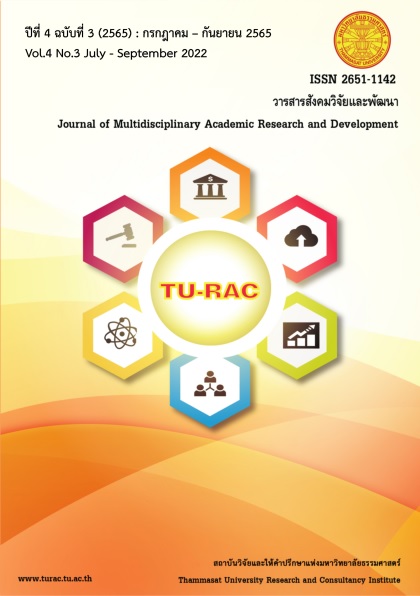Impact of the COVID-19 on the Thai Peace Index
Keywords:
Peace Index, Positive Peace Index, Negative Peace Index, Rule of Law IndexAbstract
This study had two objectives, to 1) calculate the Thailand - Global Peace Index (TPI) for 2020 and 2022; and 2) examine how the Novel Coronavirus 2019 (COVID-19) pandemic affected the TPI at the aggregate level and for each of four subindices: 1) lessening physical violence (P1); 2) safety and stability of society (P2); 3) acceptance of diversity and fair treatment (P3); and 4) social equality and fair resource distribution (P4).
Data used to construct the subindices was drawn from two surveys administered by the National Statistical Office (NSO): 1) a labor force survey with a questionnaire section developed for the purposes of this study; and 2) a socioeconomic survey. Five steps were involved to calculate each index: 1) standardizing data by Z-score; 2) statistically clustering data; 3) normalizing data to make each index unit-free; calculating national level indices; and appraising provincial level indices.
Results were that on a scale of 5, overall TPI score in 2022 (3.42) was higher than in 2020 (3.37). P1 value decreased from 3.64 to 3.61; P2 value increased from 3.23 to 3.29; P3 value increased from 3.33 to 3.44; and P4 value increased from 3.26 to 3.35. While overall P4 value increased, two subindice values declined: income inequality and land possessions. Provincial impacts varied by per capita income. Provinces with lower income per capita tended to display higher variability of COVID-19 impact on TPI values; provinces with higher incomes were able to abate such effects, displaying lower degrees of variations. These TPI values may be used for area-based policy formation. For example, in Loei Province, the P1 index showed that physical violence was significantly higher in 2022 than in 2020, calling for prioritizing policy and resource allocation to address the issue.
References
ไชยันต์ รัชชกูล (2555). โครงการมิติทางปรัชญาและวัฒนธรรมของการสร้างสันติภาพ: รายงานวิจัยฉบับสมบูรณ์. สำนักงานคณะกรรมการส่งเสริมวิทยาศาสตร์ วิจัยและนวัตกรรม.
ฟารีดา ปันจอร์. (2564). ความท้าทายของกระบวนการสันติภาพจังหวัดชายแดนใต้ในสถานการณ์แพร่ระบาดของโควิด - 19. วารสารรูสมิแล. 42(1), 29-40.
ชลัท ประเทืองรัตนา และ เกียรติอนันต์ ล้วนแก้ว. (2561). ดัชนีและตัวชี้วัดด้านสันติภาพที่เหมาะสมสำหรับสังคมไทยและผลการวัดระดับสันติภาพในสังคมไทย. สถาบันพระปกเกล้า.
ประภัสสรา พงศ์พันธุ์พิศาล, มนทยา สุนันทิวัฒน์, สมหญิง พุ่มทอง, ลือรัตน์ อนุรัตน์พานิช. (2565). ผลกระทบด้านสุขภาพจากสถานการณ์ระบาดของโควิด-19 ต่อผู้มีความบกพร่องทางการเห็นในเขตกรุงเทพมหานคร. วารสารวิจัยระบบสาธารณสุข. 16(2), 169-182.
สำนักงานสภาพัฒนาการเศรษฐกิจและสังคมแห่งชาติ. (2565). รายงานสรุปผลการดำเนินการตามยุทธศาสตร์ชาติ ประจำปี 2564. สืบค้นเมื่อวันที่ 29 มิถุนายน 2565 จาก http://nscr.nesdc.go.th/wp-content/uploads/2022/03/NS-Book_220363.pdf.
สุภารัตน์ ทองปลิว และ กัมปนาท วงษ์วัฒนพงษ์. (2564). ผลกระทบทางด้านเศรษฐกิจและสังคมต่อประชาชนจากการแพร่ระบาดของโรคติดเชื้อไวรัสโคโรนา 2019 (COVID-19) : กรณีศึกษาตำบลนครไทยอำเภอนครไทย จังหวัดพิษณุโลก. Journal of Modern Learning Development. 6(3), 107-122.
Freedom House. (2021). Freedom on the net 2021. Retrieved June 29, 2022, from https://freedomhouse.org/th/country/thailand/freedom-net/2021.
Galtung, J. (1996). Peace By Peaceful Means. Oslo: International Peace Research Institute.
Ide, T. (2021). COVID-19 and armed conflict. World development, 140, 105355.
Institute for Economics & Peace. (2020). Covid – 19 And Peace. Retrieved June 29, 2022, from https://www.economicsandpeace.org/wp-content/uploads/2020/08/COVID19-and-Peaceweb.pdf.
Institute for Economics & Peace. (2021). Global Peace Index 2021. Retrieved June 29, 2022, from https://www.visionofhumanity.org/wp-content/uploads/2021/06/GPI-2021-web-1.pdf.
Institute for Economics & Peace. (2022a). Positive Peace Report 2022. Retrieved June 29, 2022, from https://www.visionofhumanity.org/wp-content/uploads/2022/01/PPR-2022-web.pdf.
Institute for Economics & Peace. (2022b). Global Terrorism Index 2022: Measuring the Impact of Terrorism. Sydney. Retrieved June 29, 2022, from http://visionofhumanity.org/resources.
OECD. (2008). Handbook on Constructing Composite Indicators : Methodology and User Guide. Retrieved June 29, 2022, from https://www.oecd.org/els/soc/handbookonconstructingcompositeindicatorsmethodologyanduserguide.htm.
Singh, S. K., & Maddala, G. S. (1976). A Function for Size Distribution of Incomes. Econometrica. 44(5), 963–970. https://doi.org/10.2307/1911538 APA.
Downloads
Published
How to Cite
Issue
Section
License
Copyright (c) 2022 เกียรติอนันต์ ล้วนแก้ว, ชลัท ประเทืองรัตนา

This work is licensed under a Creative Commons Attribution-NonCommercial-NoDerivatives 4.0 International License.



